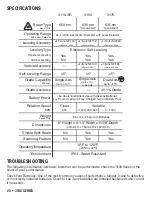
3.
Press the “
A
” button (“POWER” in the 3175) and allow the instrument to self-level. If
necessary, adjust the rotation speed to easily view the laser beam on the wall. Orient the
instrument parallel to the wall and attempt to align with your plumb line. (Fig.19)
If the laser line does not align with the plumb line, then calibration is necessary.
Laydown Position Calibration – Z axis (3150 and 3175 only)
Keep the instrument in its current position. Power OFF the instrument.
model 3150
1.
Power ON the instrument while holding the “
C
” button down. You will know if Calibration
Mode is activated when the Manual Mode and Anti-Drift LEDs flash alternately.
2. The
“
D
” and “
F
” button change the axis increments. The “
D
” button will produce a
positive (+) increment.
3.
Select the “
D
” button to rotate the laser beam counterclockwise, or the “
F
” button to rotate
the laser beam clockwise into alignment with your plumb line.(Fig. 19) For example, the beam
must rotate counterclockwise to align with the plumb line, so you must select the “
D
” button.
4.
The adjustments are automatically saved.
model 3175
1.
Power ON the instrument while holding the MODE button down.
2.
Release the two buttons at the same time and wait until calibration instructions appear on
screen. Use the right SELECT button, following the chart You find in “Calibration of the X
axis”. To access the Z axis press MODE. Please record the three-digit number that appears
in the LCD the first time you enter the axis calibration menu; this number is the factory
setting (i.e. 510), to which you can return if necessary (this number may vary anywhere
between 430 and 590).
3.
Select “+” to rotate the laser beam counterclockwise, or “–” to rotate the laser beam
clockwise into alignment with your plumb line. For example, the beam must rotate
counterclockwise to align with the plumb line, so you must select “+”.
4.
Press the MODE Button to exit the Z axis calibration menu, and save any changes to the
calibration settings by turning off the instrument (“QUIT”).
You must now repeat the peg test to insure you have made the correct calibration. A peg test can
be done in Calibration Mode.
MAINTENANCE AND CARE
Always clean the instrument after use. Use a soft, dry cloth to remove any dirt or moisture from the
instrument. Do not use benzene, paint thinner, or other solvents to clean the instrument. Store the
instrument in its case when not in use. Batteries should be removed before long-term storage.
ENVIRONMENTAL PROTECTION
Recycle raw materials instead of disposing as waste. The machine, accessories and
packaging should be sorted for environmental-friendly recycling. Do not throw used
batteries into waste, fire or water but dispose of in an environmentally friendly manner
according to the applicable legal regulations.
3100 SERIES • 19






























